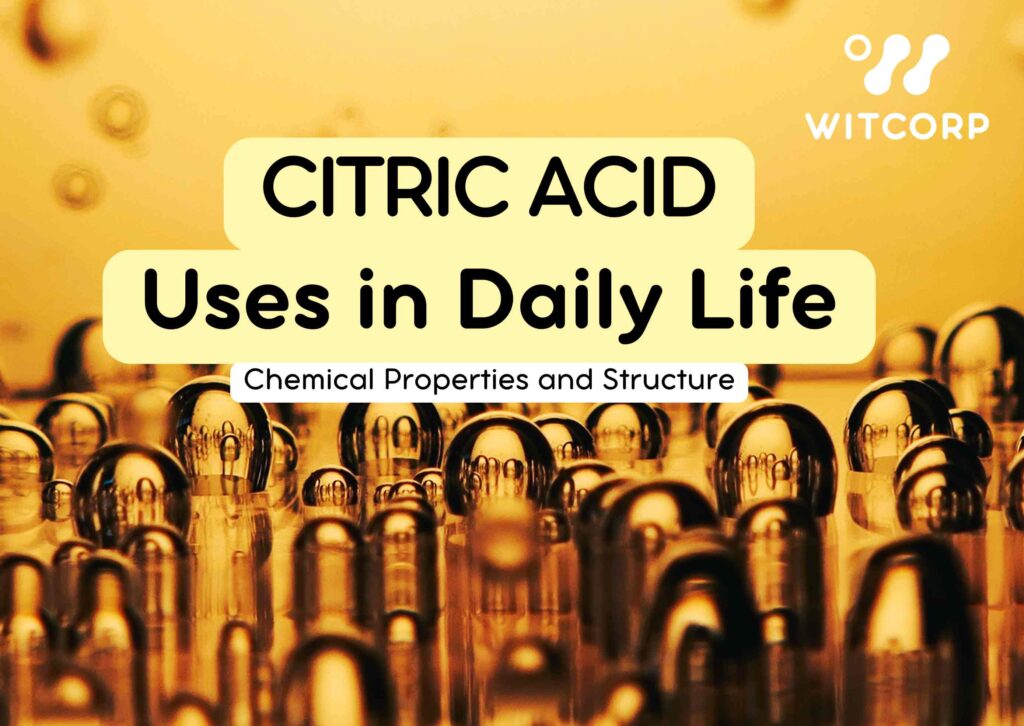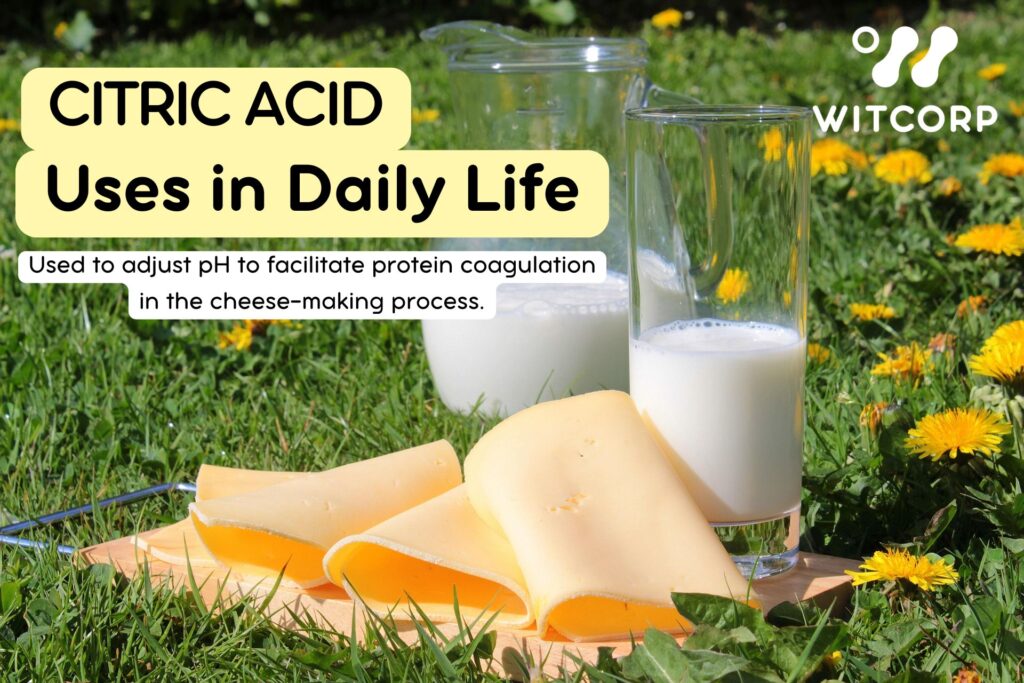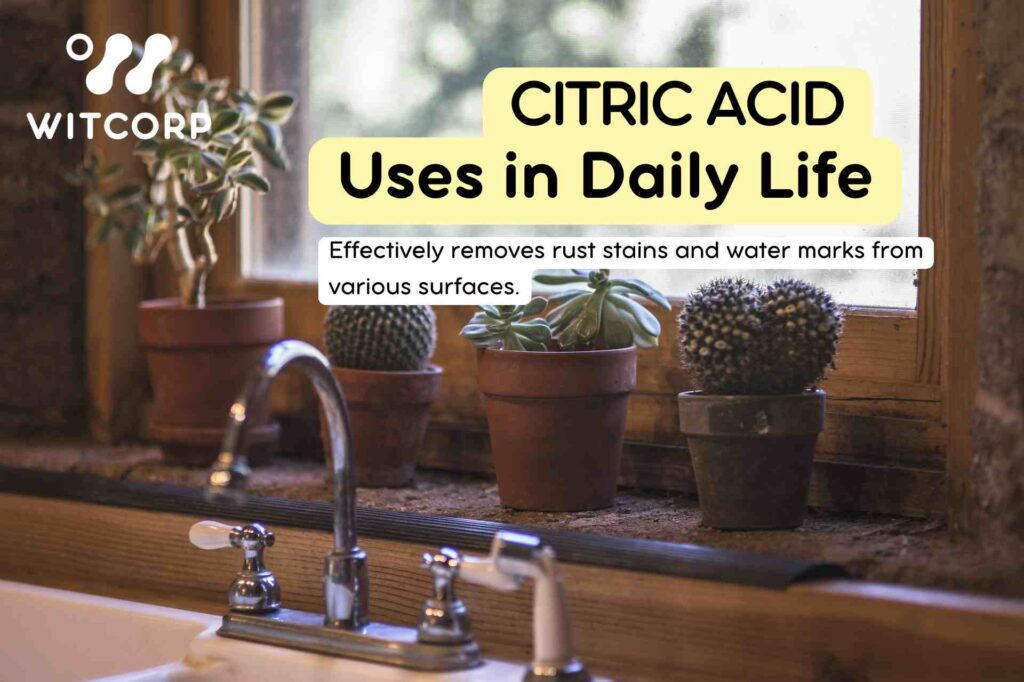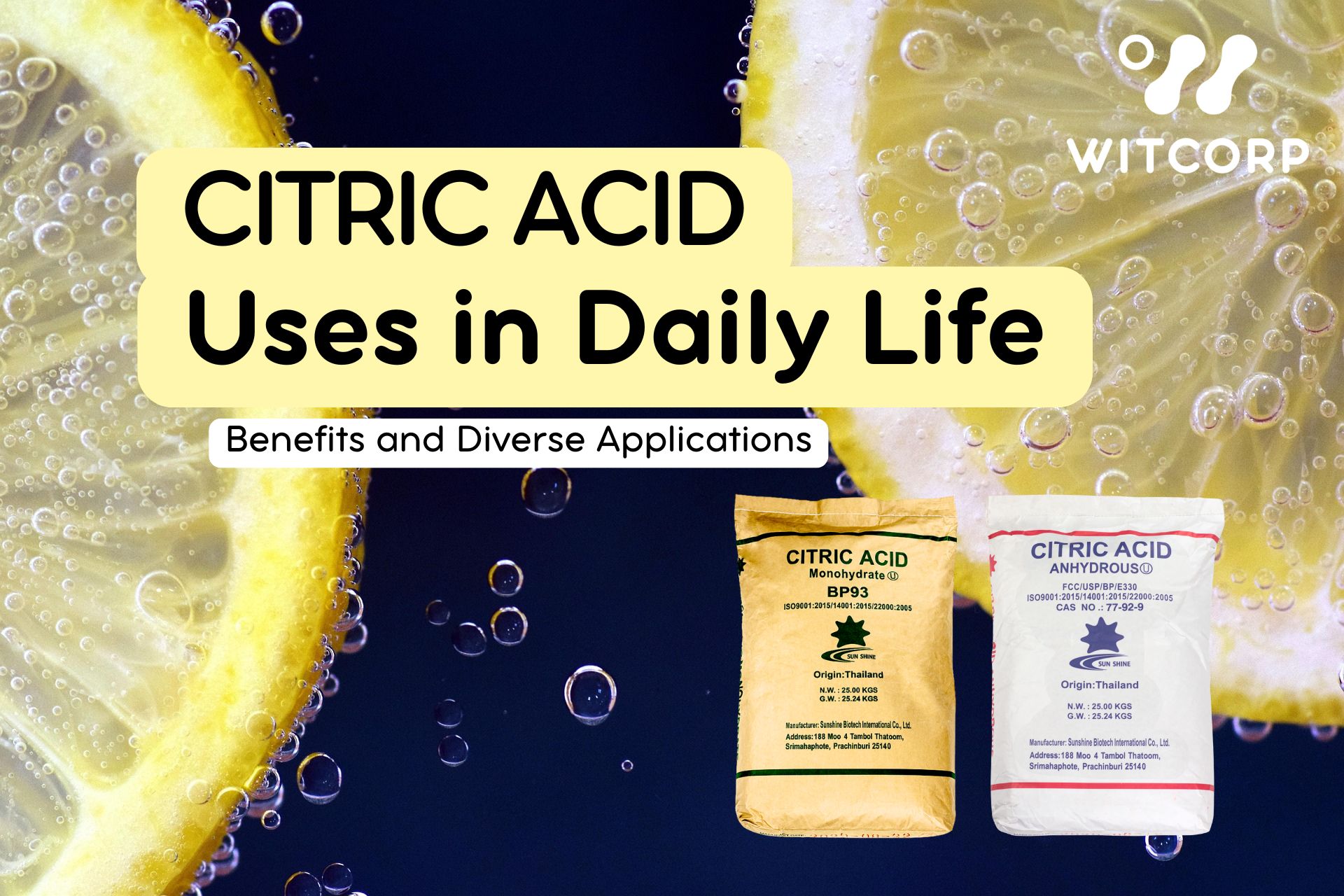Citric acid is an organic compound that occurs naturally in sour fruits such as lemons, oranges, and grapefruits. Thanks to its diverse chemical properties and high safety profile, industries widely apply citric acid in food production, cosmetics, cleaning products, and pharmaceuticals. This article will introduce you to citric acid in all its dimensions, from its chemical structure and production processes to its sustainable applications in everyday life.

Chemical Properties and Structure
Citric acid has the chemical formula C₆H₈O₇ and is a tricarboxylic acid containing three carboxyl groups (-COOH), enabling it to participate in various chemical reactions. It appears as a white crystalline powder, dissolves readily in water, and possesses a distinctively sharp sour taste.
As a weak acid, citric acid has a pH value between 3-6 and exhibits special properties as a chelating agent capable of efficiently binding with metal ions such as calcium, magnesium, and iron. Additionally, it possesses antimicrobial properties, helping to inhibit the growth of bacteria and fungi to a certain extent.
Role in Metabolic Processes
Scientists recognize citric acid not merely as a chemical found in fruits but as a crucial component in the citric acid cycle, or Krebs Cycle, which drives the primary energy production process in the cells of all living organisms.
This cycle occurs in mitochondria, the “power plants” of cells, where citric acid functions as a vital intermediate in converting glucose and other nutrients into ATP (Adenosine Triphosphate), the energy currency that cells can immediately utilize. The discovery of this cycle by Sir Hans Adolf Krebs in 1937 marked a significant milestone in understanding molecular biology.
Commercial Production
Although citric acid occurs naturally in fruits, most industrial production employs fermentation using the fungus Aspergillus niger, a process that is more efficient and cost-effective than extraction from fruits.
This fermentation process began in the early 20th century and has continuously evolved. It utilizes sugar-based raw materials such as molasses, sugarcane juice, or corn starch. The fungus A. niger converts these sugars into citric acid through its metabolic processes, producing up to 1-2 million tons annually worldwide.
Researchers are currently developing new technologies to enhance production efficiency, including genetic engineering techniques that improve fungal strains and methods that utilize agricultural waste as raw materials to reduce costs and promote environmental sustainability.

Applications in the Food and Beverage Industry
The U.S. Food and Drug Administration (FDA) has certified citric acid as safe, and food manufacturers widely use it to serve multiple functions.
Flavor Enhancement – Citric acid is an additive that provides a refreshing sour taste in various beverages such as soft drinks, fruit juices, and energy drinks, helping to balance sweetness and acidity.
Natural Preservative – With its ability to lower pH and inhibit microorganisms, citric acid helps extend the shelf life of food products, particularly processed fruits and vegetables.
Color and Quality Preservation – Citric acid prevents color changes in fruits and vegetables, such as peeled bananas or apples, by preventing oxidation reactions that cause browning.
Cheese and Dairy Production – Used to adjust pH to facilitate protein coagulation in the cheese-making process.

Applications in Pharmaceuticals and Cosmetics
In the pharmaceutical sector, citric acid plays several important roles: it serves as a pH adjuster in tablets and liquid medications, acts as a chelating agent in treating heavy metal poisoning, and is an ingredient in dialysis products to control blood acidity.
In cosmetics, citric acid has gained popularity as a gentle exfoliant that helps brighten skin, reduce dark spots, and balance skin pH. It is commonly found in products such as toners, serums, and moisturizing creams. It is also used in shampoos to remove mineral deposits and make hair shiny.

Cleaning Products and Household Applications
Citric acid is an environmentally friendly alternative for household cleaning because it is naturally biodegradable and safe for users.
Limescale Removal – Citric acid is exceptionally effective at dissolving limestone and mineral deposits that accumulate in kettles, coffee makers, shower heads, and faucets.
Cleaning Electrical Appliances – Used to clean washing machines and dishwashers to remove stains and musty odors.
Odor Elimination – Can be made into a natural deodorizing spray by mixing citric acid with water and essential oils.
Bathroom and Kitchen Cleaning – Effectively removes rust stains and water marks from various surfaces.
When citric acid is mixed with baking soda, it creates a fizzing reaction that helps remove stains and clean drain pipes effectively without relying on harsh chemicals.
Safety and Precautions
Although citric acid is safe in appropriate amounts, there are some precautions to consider. Consuming excessive amounts of citric acid may erode tooth enamel, especially when frequently drinking fruit juices or beverages with high acid content. The mouth should be rinsed with plain water after consumption.
People with sensitive skin may experience irritation when they use products containing high concentrations of citric acid. Therefore, they should test a small area before applying the product to the entire face. Additionally, inhaling citric acid powder directly may irritate the respiratory tract, so users should handle it with care and avoid breathing in the particles.
Citric Acid and Environmental Sustainability
Citric acid exemplifies a substance that strongly supports the concept of sustainable living. First of all, it is easily biodegradable in nature. Moreover, it does not generate toxic residues, and in addition, manufacturers can produce it from agricultural waste materials. By choosing citric acid instead of harsh chemicals at home, consumers can significantly reduce the release of toxins into water sources. Furthermore, this choice helps decrease plastic use from cleaning products and is especially safe for children and pets.
Conclusion
Citric acid is a natural substance with remarkable value and versatility in applications, spanning from use in the food and beverage industry to being an environmentally friendly alternative for household cleaning. With its safety, high efficiency, and sustainability, citric acid is a substance worth having in every household—a tool that helps us live mindfully and responsibly toward our health and the environment.
References
Akram, M. (2023). Citric acid cycle and role of its intermediates in metabolism. StatPearls Publishing. https://www.ncbi.nlm.nih.gov/books/NBK556032/
Berg, J. M., Tymoczko, J. L., & Stryer, L. (2023). Citric acid cycle. In Biochemistry (9th ed.). W. H. Freeman. https://www.ncbi.nlm.nih.gov/books/NBK541072/
DisThai. (n.d.). Citric acid. Retrieved November 7, 2025, from https://www.disthai.com/17314419/กรดซิตริก
HD Mall. (n.d.). What is citric acid or lemon acid and what are its properties? Retrieved November 7, 2025, from https://hdmall.co.th/blog/health/citric-acid/
Krungthep Chemi. (n.d.). Citric Acid Anhydrous – Differences and applications. Retrieved November 7, 2025, from https://krungthepchemi.com/product/citric-acid-anhydrous/
Lanagrow. (n.d.). Benefits and uses of citric acid (Citric Acid Monohydrate). Retrieved November 7, 2025, from https://www.lanagrow.co.th/blog/6894/ประโยชน์และการใช้งานกรดมะนาว-citric-acid-monohydrate
Martínez-García, R., Moreno-Medina, D. A., & Hernández-Escoto, H. (2024). Optimization of citric acid production from sugarcane molasses by Aspergillus niger. Life, 14(6), 756. https://doi.org/10.3390/life14060756
Pwai. (n.d.). Citric Acid in the food industry. Retrieved November 7, 2025, from https://pwai.co.th/blogrp-citric-acid-ในอุตสาหกรรมอาหาร/
RHK Chemical. (n.d.). Citric acid or lemon acid – Many benefits. Retrieved November 7, 2025, from https://www.rhkchemical.com/18000937/กรดซิตริก-หรือกรดมะนาว
RHK Group. (n.d.). Citric acid or lemon acid. Retrieved November 7, 2025, from https://www.rhkchemical.com/14823118/กรดซิตริก
Show, P. L., Oladele, K. O., Siew, Q. Y., Aziz Zakry, F. A., Lan, J. C., & Ling, T. C. (2015). Overview of citric acid production from Aspergillus niger. Frontiers in Life Science, 8(3), 271-283. https://doi.org/10.1080/21553769.2015.1033653
World Chemical. (n.d.). Citric acid or lemon acid – What can it do? Retrieved November 7, 2025, from https://www.worldchemical.co.th/citric-acid-หรือ-กรดมะนาว-สามารถทำ/
Yin, X., Shin, H. D., Li, J., Du, G., Liu, L., & Chen, J. (2017). Citric acid production by Aspergillus niger: A comprehensive overview. Critical Reviews in Biotechnology, 37(1), 1-15. https://doi.org/10.1080/21553769.2015.1033653
